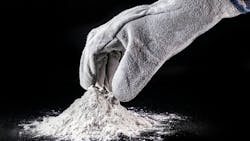Understand the Four Solvent Locations in Particulate Solids
Key Highlights
- Particulate solids are unique - They can exist as solid, liquid, and gas simultaneously, making process design challenging due to issues like clumping, pharmaceutical compression and temperature changes.
- Four types of solvent locations - Solvent can be free/surface (removed by drying), bound (adhering to particles), inherent (trapped in crystal structures) or occluded (physically enclosed in particles).
- Drying method matters - The transition from heat-transfer to mass-transfer limited drying is critical - products must be cooled before dryer removal to prevent re-absorption of moisture and clumping.
What material can have all three phases at the same time: solid, gas and liquid? Answer: Particulate Solids. The base structure of a particle is solid, and it can have voids filled with gas or liquids. This makes it difficult to design a process for solids processing.
Small changes in temperature and even pressure can lead to solids handling problems, such as clumping, loss of efficacy in pharmaceuticals and occasionally deflagration. Solvent does not have to be liquid to cause a problem. It can be condensate. An understanding of where the solvent is located can be a critical aspect of solving these types of problems.
Total solvent content is made up of four solvent locations. These are:
- Free or Surface – These are easily removed by drying, but in a production facility, time may be limited or heat may not be uniformly distributed to the solids. Most dryers are run based on the contact time or an exit temperature. While a longer time will give a dryer product, that extra time may alter the color, taste or effectiveness of the product. As the most common cause of clumping, this is the easiest to fix. To avoid this issue, determine the critical solvent content at the point drying goes from a heat-transfer limited condition to a mass-transfer situation. This critical point ensures the product is not damaged by excess heat.
- Bound – This is a physically or chemically adsorbed solvent onto the particle by cohesive, chemical or electrostatic forces. Many products need to retain this bound moisture to retain their effectiveness in the hands of the consumer. For the others, there is often a specific temperature that must be reached before the solvent can be driven off. Some types of dryers are better at removing bound solvent. These include batch vacuum dryers and fluid bed dryers with multiple drying zones. One often overlooked consideration in dryer selection is preventing moisture from re-binding to the product. Many products must be cooled before removal from the dryer to prevent this from happening.
- Inherent – Solvent molecules trapped inside the crevices of crystals or micro-pores of amorphous powders come into play when particles break. These are the most troublesome forms of solvent in particulate solids, often resulting in a short shelf life and clumping. They usually can’t be removed by drying unless they explode, but their effect can be minimized, especially after a milling process, by purging the product with dry gas. Solvents of hydration and/or crystallization are part of this group, but they are a stable form of the chemical that would only be released by a phase change or chemical reaction. Drying tests don’t identify this form of solvent. The particles must be dissolved or micronized to find them.
- Interstitial – This is usually solvent vapor that fills the voids of the bulk material. Although a very small amount, it plays an important role in caking mechanisms and chemical decomposition. When this source is identified as part of the problem, it is fairly easy to purge by fluidizing with dry gas.
There are eight common methods for determining the solvent in a particulate solid. Some are specific to the most common solvent, water. Each one can yield a slightly different result due to the technique, so it is essential to communicate your analysis method to your customer.
To understand clumping and propose the correct solution to a problem, it is essential to know the origin of the solvent. None of these methods will reveal all four types of solvent directly. However, DTA (Differential Thermal Analysis) and DSC (Differential Scanning Calorimetry) can be run in a manner that allows the computation of all four forms of the solvent. The measurement methods are:
- Karl Fischer – free and bound moisture (other chemicals can be used to titrate the solid for the presence of other solvents)
- Loss on drying (LOD) – free or surface solvent and a major portion of bound solvent (for moisture, this is usually 90oC for 6 hours)
- Infrared – surface moisture, a close approximation to free moisture
- Radio frequency – inherent (sometimes), bound and free moisture
- Microwave – total and interstitial moisture (using different wavelengths)
- Loss on ignition – total solvent (can be done following LOD to get solvent of crystallization)
- Thermo-gravimetric analysis – total solvent loss with time: DTA is a more precise variation for solvent flux (can be combined with GC-MS to identify chemicals in a multi-component solvent system)
- DSC – heat flow with time (especially useful in multi-component solvent systems)
As you can see, determining solvent content can be complicated and is crucial to ensure you and your customer are on the same page. This short discussion should help you in troubleshooting drying or quality problems.
About the Author
Tom Blackwood, Solids Advice columnist
Contributing Editor
Tom Blackwood, a veteran engineer who has dealt extensively with solids over the course of his career, contributes regularly to Chemical Processing and serves as the Solid Advice columnist.

